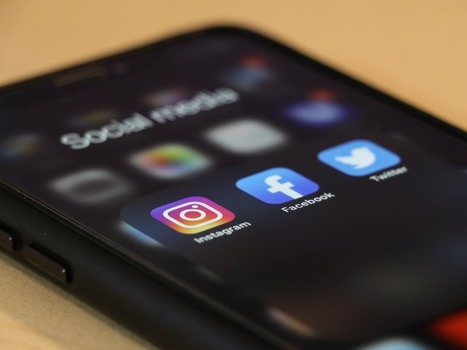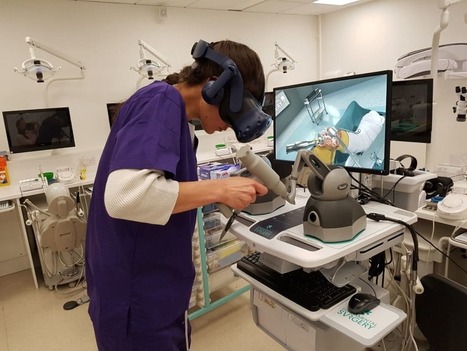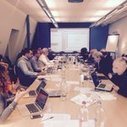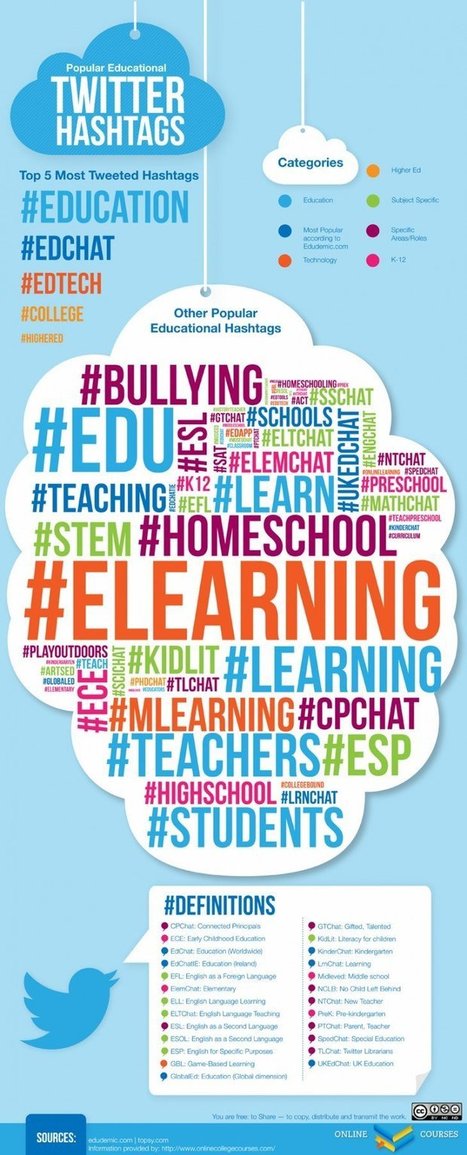 Your new post is loading...
 Your new post is loading...

|
Scooped by
Gilbert C FAURE
April 1, 1:33 PM
|
5 Reasons Why Health Professionals Need Social Media-Based CME
The continuing education landscape is evolving rapidly, and social media is at the forefront of… | 10 comments on LinkedIn

|
Scooped by
Gilbert C FAURE
August 6, 2022 5:18 AM
|
AJNR Podcasts Welcome to AJNR Podcasts, a monthly audio digest bringing you news in the field of neuroradiology and highlighting significant articles from the current issue of AJNR. Podcasts are available to download below or at the following: Browse the Podcast Archives Here. Latest Releases August 2022 Annotated Bibliography Podcast Right click to download and save file Join Editor-in-Chief Jeffrey Ross for the August AJNR Blog Annotated Bibliography podcast, featuring an audio tour of 8 recently published articles and 1 commentary. The American Society of Neuroradiology is accredited by the Accreditation Council for Continuing Medical Education (ACCME) to provide continuing medical education for physicians. Visit the ASNR Education Connection website to claim CME credit for this podcast. June 2022 Podcast Right click to download and save file This month's guest is Dr. Kevin Abrams. He discusses his article, "Perfusion Scotoma: A Potential Core Underestimation in CT Perfusion in the Delayed Time Window in Patients with Acute Ischemic Stroke," one of the June issue's Fellows' Journal Club selections. April 2020 Fellows' Journal Club Podcast Right click to download and save file The Journal Club returns to the Medical College of Wisconsin in Milwaukee, where Mohit Agarwal used Zoom technology to moderate a socially distanced discussion of 4 articles focused on the glymphatic system: Kiviniemi V, Wang X, Korhonen V, et al. Ultra-fast magnetic resonance encephalography of physiological brain activity – glymphatic pulsation mechanisms? J Cereb Blood Flow Metab 2016; 36:1033–45 Komlosh ME, Benjamini D, Williamson NW, et al. A novel MRI phantom to study interstitial fluid transport in glymphatic system. Magn Reson Imaging 2019;56:181–86 Watts R, Steinklein JM, Waldman L, et al. Measuring glymphatic flow in man using quantitative contrast-enhanced MRI. AJNR Am J Neuroradiol 2019;40:648–51 Edeklev CS, Halvorsen M, Lovland, G et al. Intrathecal use of gadobutrol for glymphatic MR imaging: prospective safety study of 100 patients. AJNR Am J Neuroradiol 2019;40:1257–64 PODCAST EDITOR Courtney Tomblinson, MD, is an Assistant Professor of Radiology at Vanderbilt University Medical Center where she specializes in neuroradiology. She is Associate Program Director for the DR residency program, and serves as Co-Chair of the ASNR Young Professionals Section. In 2018, she was awarded the ACR Valerie P. Jackson Education Fellowship, is a contributor to the JACR Early Career Corner, and serves as Radiographics Contributing Editor to Social Media and Digital Innovation. Dr. Tomblinson's other interests include gamification and digital tools in medical education, and mentorship. You can reach her by email using the Ask the Editor button or on Twitter @cmtomblinson. Click above to send a note to Dr. Tomblinson. PODCAST DEPUTY EDITOR Kevin Hiatt, MD, is a current second year neuroradiology fellow at Wake Forest Baptist Medical Center and will be starting a position as an Assistant Professor of Radiology at Wake Forest beginning in July 2021. He is the faculty mentor for the Radiology Interest Group at Wake Forest and is the chair for the Future Radiologist Outreach Group for the North Carolina chapter of the ACR. Dr. Hiatt's interests include mentorship and integrating technology in medical education. You can reach him by email using the Ask the Editor button or on Twitter @kdhiatt. Click above to send a note to Dr. Hiatt. Music 2012 and Before: AJNR podcasts feature "Confrontation," reproduced with permission of Flavio Simone Creative Commons Attribution and music performed by the Orchestra "Gli Armonici." 2013 until 2019: AJNR podcasts feature Johann Sebastian Bach's "Brandenburg Concerto No.5 in D major," performed by Constance Schoepflin (flute), Roxana Pavel Goldstein (violin), and Matthew Ganong (harpsichord) with the Advent Chamber Orchestra, reproduced with permission under a Creative Commons Attribution Non-commercial Share Alike 3.0 license. In this issue American Journal of Neuroradiology Vol. 43, Issue 7 1 Jul 2022 Table of ContentsIndex by authorComplete Issue (PDF) Search for this keyword Sign up for alerts

|
Scooped by
Gilbert C FAURE
November 6, 2020 12:48 PM
|
Background/Purpose: Twitter is a popular social media platform that is widely used to publish information and exchange ideas. There are over 300 million active monthly users on Twitter with about 500 million tweets sent daily. Therefore, Twitter is a unique tool with the ability to distribute ideas and information rapidly and widely to a large […]

|
Scooped by
Gilbert C FAURE
October 29, 2020 12:04 PM
|
BAUS is excited to announce that the BAUS 2020 Annual Meeting will be held virtually, with an exciting & dynamic programme and an interactive virtual platform. The BAUS 2020 virtual platform has been planned with a wide range of features: Activity wall Virtual exhibition Interactive home feed (for comments & photos) Discussion & comments area Augmented reality Live streaming of sessions Dynamic & exciting programme Polling Virtual 1:1 or group meetings Ability to watch for 12 months Activity challenge (win a pair of Apple AirPods) ... plus much more Abstracts will be available online in the Conference Edition of the Journal of Clinical Urology (JCU) from 07:00hr on Monday 9 November 2020 Programme There will be three sessions per day and three concurrent streams playing content during each session. Virtual exhibition viewing will be available between the sessons: SESSION 1 SESSION 2 SESSION 3 Mon 09 Nov view streams Tue 10 Nov view streams Wed 11 Nov view streams 08.00 - 10.00hr 08.00 - 10.30hr 08.30 - 10.00hr 12.00 - 14.45hr 12.00 - 14.45hr 12.00 - 14.00hr 16.00 - 18.00hr 16.00 - 18.00hr 16.00 - 18.00hr Download the full BAUS 2020 Virtual Final Programme Registration Click to register on-line for BAUS 2020 Virtual Registration for BAUS Members and Non-Members is now open. Registration is free for all BAUS Members and will be available until 10:00 (GMT) on 5 November 2020. Non-Member Fees Non-Member: Urologist / Other - Whole Meeting £50 Non-Member: Trainee/Health Care Professional, Nurses, Administrators, Radiographers/ Scientists/ Foundation & Core Trainees - Whole Meeting £25 BAUS 2020 Virtual Platform In the lead up to BAUS 2020 Virtual Annual Meeting, you will receive an email with a link to access the web app or mobile app. We have put together a How-to-Guide of the BAUS 2020 virtual platform to give delegates a detailed look into the user friendly features with step by step instructions. Download the BAUS 2020 How-to-Guide. Continuing Medical Education This meeting has been accredited with CME points as follows: Monday 9 November - 6 points Tuesday 10 November - 6 points Wednesday 11 November - 6 points ePosters Full details of the presenters and ePosters will be available to view on the meeting platform. For this year, ePoster sessions will run in a different manner. Each ePoster session has been allocated a 30-minute slot, where the co-chairs will provide a round-up review of the ePosters and will define the "take-home" messages and key discussion points. Social Media Keep up-to-date with all BAUS 2020 information via Twitter @BAUSUrology, use the hashtag #BAUS20 and view sessions on YouTube (BAUS TV). For additional information, please view the BAUS 2020 Virtual video below: This event is approved for CME Organised by: The BAUS Events Team of the British Association of Urological Surgeons

|
Scooped by
Gilbert C FAURE
September 29, 2020 11:42 AM
|
Journal of Medical Internet Research - International Scientific Journal for Medical Research, Information and Communication on the Internet...

|
Scooped by
Gilbert C FAURE
January 14, 2020 2:39 AM
|
Bringing Back #radonc Journal Club on Twitter After a hiatus, we are excited to announce restarting #radonc journal club on Twitter! From 2014-2017, we had almost monthly discussions on cancer research with our last being September 2018.

|
Scooped by
Gilbert C FAURE
December 21, 2019 11:20 AM
|
“The AAOS strives to ensure that educational programs designed for orthopaedic surgeons meet the criteria of the accreditation requirements of the Accreditation Council for Continuing Medical Education,” said Anna Salt Troise, Chief Education Strategist, AAOS. “For the first time, we’re expanding these programs into the VR space to help our members and residents experience and navigate the same visuals, sounds and feelings they would during a real surgical procedure while obtaining CME credits. The Fundamental Surgery TKA simulation does just that by offering both an exciting training opportunity, as well as a look at how VR training is guiding the future.” “Educational sources of learning and member development, such as the AAOS, provide significant value to surgeons in practice and training through quality assured courses, online content and now with our Haptic VR simulations.” said Peter Rainger, Chief Learning Officer of Fundamental VR. “We’re truly delighted to have been awarded accreditation and will continue to work with the AAOS on our library of orthopaedic simulations, ensuring they meet the stringent educational quality criteria, and allowing us to offer training that is valuable for trainees as well as attending surgeons.” About Fundamental Surgery Named as one of the best inventions of 2018 by Time magazine, the Fundamental Surgery platform combines virtual reality (VR) with cutting-edge haptics to create a scalable ‘flight simulator’ experience for surgeons. They’ll feel the movement and interaction of tissue, muscle and bone which reflects the experience in a procedure, and is proven to support knowledge and surgical skills transfer. Additionally the use of haptics enables highly accurate data capture and subsequent analysis. Fundamental Surgery has a library of tools and tissue variants that mimic real life sensations that have been calibrated by a leading team of surgeons and KOLs. Fundamental Surgery is being developed and deployed in partnership with hospitals and medical device companies in Orthopedics, Ophthalmology, Vascular, Cardiothoracic, General and Neurosurgery. For further information about Fundamental Surgery, please visit: www.fundamentalsurgery.com. About the AAOS With more than 39,000 members, the American Academy of Orthopaedic Surgeons is the world’s largest medical association of musculoskeletal specialists. The AAOS is the trusted leader in advancing musculoskeletal health. It provides the highest quality, most comprehensive education to help orthopaedic surgeons and allied health professionals at every career level best treat patients in their daily practices. The AAOS is the source for information on bone and joint conditions, treatments and related musculoskeletal health care issues and it leads the health care discussion on advancing quality. For more information about the AAOS, visit AAOS.org or follow the AAOS on Facebook, Twitter and Instagram. Fundamental Surgery Contact: Ian Twinn / Tandem Marketing Communications iantwinn@tandemcomms.com | (917) 306-7270 SOURCE: Fundamental Surgery, PR Newswire, 19th December 2019 Related Links https://www.fundamentalsurgery.com

|
Scooped by
Gilbert C FAURE
December 13, 2019 4:11 AM
|
Follow the conversation on Twitter #PrescribingCompetence This conference focuses on demonstrating and improving prescribing competence and practice and use of the National Competency Framework for all Prescribers. “The updated Competency Framework can be used by any prescriber at any point in their career. It can also be used by regulators, education providers, professional organisations and specialist groups to inform guidance, education and advice. It outlines ten key prescribing competencies under two areas: the consultation, and prescribing governance. Within these areas, statements describe the activity or outcomes prescribers should be able to demonstrate.” NICE “The requirements of the competency framework will be the standards we consider safe and effective prescribing practice for all prescribers on our register... Prescribers on our register should refer to the competency framework and other relevant sources of information and guidance to inform their ongoing prescribing practice.” NMC 2019 Through national updates, practical case studies and extended expert sessions, this conference focuses on demonstrating and improving prescribing competence and practice – embedding the competency framework, and ten competency dimensions for all prescribers. This conference will enable you to: Network with colleagues who are working to improve prescribing competence and practice Understand the national context of your prescribing practice Examine how to self assess, reflect and audit prescribing practice against the ten competency dimensions Embed the framework into practice and demonstrate competence Reflect on the new Competency Framework for Designated Prescribing Practitioners Learn from others to improve prescribing governance and accountability Understand how to demonstrate prescribing proficiency Self assess and reflect on your own practice Gain CPD accreditation points contributing to professional development and revalidation evidence 100% of delegates at a previous conference on this subject would recommend the event to a colleague

|
Scooped by
Gilbert C FAURE
March 8, 2019 8:40 AM
|
Experienced users are convinced that engaging in interactive-heavy social media like Twitter—which can work synergistically with blogs and podcasts—can be an asset rather than a distraction for already busy hospitalists.

|
Scooped by
Gilbert C FAURE
February 11, 2018 1:45 PM
|

|
Scooped by
Gilbert C FAURE
March 1, 2017 11:16 AM
|
Journal clubs have typically been held within the walls of academic institutions and
in medicine have served the dual purpose of fostering critical appraisal of literature
and disseminating new findings. In the last decade and especially the last few years,
online and virtual journal clubs have been started and are flourishing, especially
those harnessing the advantages of social media tools and customs. This article reviews
the history and recent innovations of journal clubs. In addition, the authors describe
their experience developing and implementing NephJC, an online nephrology journal
club conducted on Twitter.

|
Scooped by
Gilbert C FAURE
January 8, 2017 2:54 AM
|
Importance New dissemination methods are needed to engage physicians in evidence-based continuing medical education (CME). Objective To examine the effectiveness of social media in engaging physicians in non-industry-sponsored CME. Design We tested the effect of different media platforms (e-mail, Facebook, paid Facebook and Twitter), CME topics, and different “hooks” (e.g., Q&A, clinical pearl and best evidence) on driving clicks to a landing site featuring non-industry sponsored CME. We modelled the effects of social media platform, CME topic, and hook using negative binomial regression on clicks to a single landing site. We used clicks to landing site adjusted for exposure and message number to calculate rate ratios. To understand how physicians interact with CME content on social media, we also conducted interviews with 10 physicians. Setting The National Physicians Alliance (NPA) membership. Participants NPA e-mail recipients, Facebook followers and friends, and Twitter followers. Main Outcomes and Measures Clicks to the NPA’s CME landing site. Results On average, 4,544 recipients received each message. Messages generated a total of 592 clicks to the landing site, for a rate of 5.4 clicks per 1000 recipients exposed. There were 5.4 clicks from e-mail, 11.9 clicks from Facebook, 5.5 clicks from paid Facebook, and 6.9 clicks from Twitter to the landing site for 1000 physicians exposed to each of 4 selected CME modules. A Facebook post generated 2.3x as many clicks to the landing site as did an e-mail after controlling for participant exposure, hook type and CME topic (p<0.001). Twitter posts (p = 0.13) and paid Facebook posts (p = 0.06) were not statistically different from e-mail in generating clicks to the landing site. Use of different hooks to engage physicians had no impact on clicks to the landing site. Interviews with physicians suggested that social media might not be a preferred vehicle for disseminating CME. Conclusions Social media has a modest impact on driving traffic to evidence-based CME options. Facebook had a superior effect on driving physician web traffic to evidence-based CME compared to other social media platforms and email.

|
Scooped by
Gilbert C FAURE
May 3, 2016 3:30 AM
|
|

|
Scooped by
Gilbert C FAURE
December 24, 2022 10:11 AM
|
This accredited CME Tweetorial presents a collection of individually threaded tweets addressing the high rate of influenza transmission among household members. It provides a comprehensive overview of transmission, exposure risk, and antiviral prevention strategies across the family unit.

|
Scooped by
Gilbert C FAURE
February 23, 2021 2:54 AM
|
The aim is to provide cardiology trainees with core knowledge on inherited cardiac conditions as appropriate to the training curriculum. The learning objectives are as follows: Gain an overview of channelopathies likely to be encountered in clinical practice and how to apply the assessment framework Gain an overview of inherited vascular diseases likely to be encountered in clinical practice and how to apply the assessment framework Outline further training opportunities in ICC and the approaches for advanced modular training Understand the role of exercise in relation to the risk stratification and management of patients with ICC A CPD certificate with CPD credit will be issued to those joining the webinar live as well as those who watch the recording afterwards. Certificates will be issued 7 days after the webinar to those who watch it live and after 30 days for those that watch the recording. Join in the conversation online using Follow us on Twitter: @RoySocMed

|
Scooped by
Gilbert C FAURE
November 1, 2020 1:28 PM
|
Registration - Scientific Sessions 2020 November 13–17, 2020 | A virtual experience Register now Your Registration includes: OnDemand™ access through Jan. 4, 2021 3 days of Resuscitation Science Symposium access 35 CME and MOC credits available Meaningful networking opportunities CPR guidelines Register Now Special Pricing! AHA Professional Partners pay just $49 Non Partners pay only $99 Media Registration Are you a member of the media who wants to cover the important science presented this year? Visit the Scientific Sessions 2020 Newsroom to get started. Here's your chance to win an iPad Twitter can deliver some of the top thought leaders in cardiovascular science right to your phone. Now you can use Twitter and #AHA20 to win something everyone can use -- a free iPad! See rules, regulations, more. Registration Information Scientific Sessions 2020 November 13–17, 2020 A virtual experience Media Registrants Reporters, writers, producers or editors with credentials from a newspaper, magazine, online news service, radio or TV network or station, wire service and syndicate may register to attend Scientific Sessions 2020. Media interested in attending should contact the Corporate and Media Communications office at (214) 706-1396 or visit the newsroom website. Refunds Scientific Sessions and Resuscitation Science Symposium ( ReSS) 2020 is non-refundable. Included with registration is complimentary access to all content via OnDemand until January 4, 2021. Payment Details Full payment must be received with your registration. Acceptable forms of payment are American Express, Discover, Visa or MasterCard. Registrations without complete payment will not be processed. Wire transfers and purchase orders are not accepted. Written Confirmation Registrants will receive written confirmation/receipt of registration via e-mail. AHA Harassment Policy The AHA requires that all faculty, attendees, exhibitors, presenters, contractors, vendors and volunteers of this AHA meeting comply with all federal, state and local laws and regulations, including those that prohibit harassment and discrimination against individuals based on their race, color, religion, sex, sexual orientation, gender identity or national origin. American Heart Association Professional Partners Enjoy instant benefits! Free Online Access to AHA Scientific Journals Affiliate with our 16 Scientific Councils Discounts on Scientific Conference Registration and Online Courses

|
Scooped by
Gilbert C FAURE
October 2, 2020 11:11 AM
|
13th European CME Forum (#13ECF) – Virtual 4-6 November 2020 European and global CME: What next? We are putting together a fast-moving agenda where we ask the questions that are on everyone’s lips, difficult questions, curious question, or just your own question. We want to get to the what, where, when, who, what and how of CME in Europe across the globe. What is your question? But not just that, who would you like to answer it? Add your views in our annual CME survey, and use it to let us know your question about CME today. The Call for Abstracts is open, we are looking for interesting posters and short presentations that can support the main agenda of the meeting. You can find more information here and the application here. Closing date is Monday 5 October. The 13th Annual European CME Forum (#13ECF) is for anyone with an interest in European and global CME. We attract the key stakeholders in European and global CME-CPD/IME, regulators, associations and providers across Europe, North America and the world. This meeting is designed to meet the needs of anyone involved in, or interested in, European and global CME. Make sure you add your voice to the annual CME survey, there is a 10% discount code on the last page, and keep in touch by following us on Twitter and Linked In, or just email us — let us know what you would like to experience at #13ECF as we finalise plans. Day 1: Wednesday 4 November 2020 Opening of the 13th Annual European CME Forum Start: 12.00 CET (6.00am Eastern Standard Time/15.00 Gulf Standard Time) What do you want to know? A live needs assessment, including review of the Annual CME Survey (open to all to participate before the meeting), to ensure the meeting addresses the key questions, topics and concerns the participants identify. Session 1 start: 12.30 CET (6.30am EST/15.30 Gulf) Session 2 start 15.30 CET (10.00am EST/18.00 Gulf) Day 2: Thursday 5 November 2020 Session 3 start: 12.00 CET (6.00am EST/15.00 Gulf) Session 4 start 15.00 CET (9.30am EST/17.30 Gulf) Day 3: Friday 6 November 2020 Session 5 start: 12.00 CET (6.00am EST/15.00 Gulf) Session 6 start: 15.00 CET (9.30am EST/17.30 Gulf) Close: 17.00 CET (12.00 EST/20.00 Gulf)

|
Scooped by
Gilbert C FAURE
April 28, 2020 2:52 PM
|
Social media is a powerful tool that has the potential to transform continuing medical education (CME). Whilst online learning in medical education is well esta

|
Scooped by
Gilbert C FAURE
January 11, 2020 6:14 AM
|
Follow the conference on Twitter #CardioEoL This conference focuses on improving end of life care for people with Cardiovascular Disease and Heart Failure through a person centred approach. Through national updates and practical case studies the conference aims to support you to meet the end of life care needs for people with heart disease. The conference will also discuss starting difficult conversations: talking to people with heart failure about end of life care & advance care planning, and understanding progression of Heart Failure: Predicting and recognising last days of life and managing uncertainty. “Heart and circulatory diseases cause more than a quarter of all deaths in the UK, that’s nearly 170,000 deaths each year – an average of 460 deaths each day or one every three minutes in the UK.” British Heart Foundation “There is extensive evidence that the distress faced by those living and dying with advanced heart failure is similar, and in many cases more severe, than those dying of cancer. Yet very few patients are referred for palliative or hospice support by their primary care or hospital cardiology teams.” Hospice UK This conference will enable you to: Network with colleagues who are working to improve end of life care for people with cardiovascular disease and heart failure Learn from the experience of someone living with heart failure Reflect on national developments and learning Understand what excellence in end of life care for heart failure looks like in practice Improve the approach to talking to people with heart failure about end of life care & advance care planning Learn from services developing pioneering models of palliative care for patients and their carers living with advancing heart failure Ensure effective psychological support Reflect on progression of Heart Failure: Predicting and recognising last days of life and managing uncertainty Understand how you can improve symptom control, hydration & prescribing Self assess and reflect on your own practice Gain CPD accreditation points contributing to professional development and revalidation evidence

|
Scooped by
Gilbert C FAURE
December 21, 2019 11:16 AM
|
Using nursing tweetchats for CPD - again ! Monday 27th April 2015 by @AgencyNurse Waaaayyyy back in 2012 we wrote a little blog about How to get the best out of Twitter chats for CPD and since then we have been doing a whole heap of tweet chatting !!! However things have moved forward slightly and in the light of revalidation for nurses coming into force we thought it was about time we revisited our thoughts on Twitter chats and CPD. The use of social media for continuing professional development and learning is becoming more common place and accepted within healthcare as many have come to realise the knowledge exchange that occurs in these spaces. Moorley & Chinn (2014) state "Continuous professional development may use formal approaches to learning such as training sessions, classroom events (e.g. lectures) or education workshops. Informal learning may take the form of face to face conversations with colleagues or verbal feedback on actions or performance. As a result of the World Wide Web these approaches to knowledge sharing and transmission can extend to online environments. One such environment is social media using the platform Twitter. Twitter can be used as a learning resource; there are metrics that show healthcare conversations on Twitter. Symplur a provider of Health Care Social Media Analytics revealed there were 410 Million Healthcare Tweets." So with Twitter chats firmly placed on the CPD map here are a few tips to make the most out of them: 1. Be prepared - Have a read of the pre chat information for the Twitter chat you are going to participate in or watch. You can find out about all of the We Community chats coming up here, so read up ! 2. Take part - During the chat either get involved by taking part in the discussion maybe favourite some of their tweets to refer to later. Take a note on comments and people that got you thinking. 3. Feel free to lurk - Of course not everyone feels that they can actively take part in a Twitter chat, so feel free to lurk and watch the discussion, sometimes this can be just as valuable. 4. Reread, catchup and reflect - After the Tweetchat a transcript is produced and this allows you to go over the chat in your own pace and a reflect. A summary of the Tweetchat is also available afterwards - this is intended as a quick guide or reflection as to what the main points of the chat were. The transcript and summary are also handy if you missed the discussion but still want to read the main points. 5. Write your own summary / reflection - Reflect on what you have learnt, you may even like to blog or video blog about it, or simply print it out and add it to your portfolio. You can even share your own summary in the comment box under each We Community chat summary. The NMC's Provisional Revalidation Guidance states that you need to record the following: Date of CPD Number of hours Number of participatory hours CPD method Topic description & how it relates to my practice The identification of the relevant part of code the CPD relates to Evidence of activity You may also wish to include: Why did you think this chat would be relevant to you, what did you hope to gain? What twists and turns did the chat take, how did opinions differ from participants vary? Did you pick up any ideas to discuss with colleagues later, or even change the way you currently nurse? Do you need to do anything more to follow up your learning? We have created a very simple form that you can add to your portfolio to help you: Chose between a word version to complete digitally or a PDF version to print and complete For more information on revalidation please visit The NMC's Revalidation Guidance & Resources Posts Please feel free to post in to this blog; you'll need to be logged in via twitter from the top right of the menu to post. @{{Comment.screenName}} {{Comment.DateCreated | date:"dd MMMM yyyy HH:mm"}} {{Comment.Comment}}

|
Scooped by
Gilbert C FAURE
September 17, 2019 4:29 AM
|
Upcoming Courses: Kauai, Hawaii September 16-20, 2019 Imaging in Hawaii LEARN MORE Kauai, Hawaii November 11-14, 2019 A Masters Course in Chest Imaging LEARN MORE Beaver Creek, Colorado January 6-10, 2020 Winter Imaging in Beaver Creek LEARN MORE The Bahamas February 3-6, 2020 Imaging in the Bahamas LEARN MORE Jackson Hole, Wyoming February 24-28, 2020 Winter Imaging Update in Jackson Hole LEARN MORE Maui, Hawaii March 23-26, 2020 Imaging in Hawaii LEARN MORE Kauai, Hawaii March 30-April 2, 2020 Imaging in Hawaii LEARN MORE Jackson Hole, Wyoming July 13-16, 2020 Imaging at Jackson Hole LEARN MORE Maui, Hawaii July 20-23, 2020 Imaging in Hawaii LEARN MORE About CME Science CME Science is dedicated to promoting and coordinating the development and dissemination of educational content that is relevant and meaningful to clinical practice and to serving the health care needs of the general public through the support of science, teaching, and research. The Diagnostic Imaging Update courses are designed to cover relevant and varied topics over the span of four to five days in locations that are relaxing, beautiful and conducive to learning. Our faculty professors hail from top universities, colleges and medical centers that include Stanford, UCLA, UCSD, UCSF, Duke, Baylor, Loma Linda, Brown University, University of Michigan and Mount Sinai School of Medicine All Diagnostic Imaging Update courses offer AMA PRA Category 1 CME credit and ARRT Category A CE credit. Follow us on Twitter HOLD THE DATE Webb, Müller & Naidich: A Masters Course in Chest Imaging August 3-6, 2020 Fairmont Banff Springs, Alberta, Canada

|
Scooped by
Gilbert C FAURE
from Rheumatology-Rhumatologie
December 19, 2018 1:38 PM
|
Shoulder Screening Course In this course you will learn how to systematically work through a process of screening the patient for red flags, other causes of shoulder pain, obtaining appropriate diagnostic imaging, and then classifying shoulder pain into categories that guide management. Modules: Red Flags You will learn to screen for red flag indicators of potentially serious pathology and refer the patient for necessary evaluation within an appropriate time-frame. Click here to register Health Screening You will learn current health guidelines for alcohol, tobacco and physical activity, and how to screen for risk factors and atypical symptoms and signs of medical conditions that may present with shoulder symptoms. Click here to register Pain and Psychosocial Modifiers In this module you will learn the pathoaetiology and features of various pain states, including the mechanisms behind persistent pain. You will learn how to screen for and manage psychosocial factors and learn about their relationship to persistent pain. Click here to register Cervical Spine and Neurological Examination In this module you will learn about the difference between somatic and radicular pain and how to examine the cervical spine to identify local, or referred pain. You will learn the diagnostic features of cervical radiculopathy, how to perform an accurate and thorough neurological examination. Click here to register Shoulder Imaging In this module you will learn about the strengths and limitations of imaging modalities, indications for imaging, prevalence of imaged pathology and how to read and interpret basic shoulder x-ray views. Click here to register Diagnostic Classification of Shoulder Conditions This module defines “diagnosis”, highlights the importance of the diagnostic process, provides a brief overview of diagnostic accuracy and presents a clinical classification system for shoulder conditions that forms the basis of the modules in the “Diagnosis and Non-Surgical Management” Course. Click here to register Course Aim To produce practitioners who can: Accurately screen patients presenting with shoulder girdle symptoms for red flags, and other causes of symptoms that may require additional investigations or treatment in the primary contact setting. Read basic shoulder x-ray views and interpret findings in the context of patient symptoms. Classify patients with shoulder symptoms into diagnostic categories that help guide management. Learning Outcomes By the end of the course, the participant will be able to: Identify red flag indicators of serious pathology and refer appropriately. Undertake an efficient and effective health screen for lifestyle and health risk factors, and symptoms and signs of systemic medical conditions presenting with shoulder pain and refer appropriately. Describe the features of different pain states, the mechanisms underpinning persistent pain, and explain the relationship of psychosocial factors to persistent pain. Competently perform an examination of the cervical spine and neurological examination of the upper limb to identify pain referred from the cervical spine or evidence of neurological compromise. Appropriately refer for diagnostic imaging, and describe the strengths and limitations of basic shoulder x-ray views for identifying specific shoulder pathology. Describe the diagnostic classification of the main categories of shoulder conditions that can be identified clinically to guide management. Social Learning Online Forum Those enrolled in all modules in this course will be invited to attend the online forum led by Dr Angela Cadogan, The purpose of this informal online forum is to ask any questions you have from the online learning material and to discuss any patient cases. A link to the forum will be sent to all those enrolled the full course closer to the time. See the SMS website for online forum dates. Facebook Group Those who complete all modules in this course will be invited to join the “Stiff Shoulder” Facebook Group upon completion of the course. Membership to this Group is indefinite. This Group contains social learning units where latest research and updates are organised by topics that align with the modules in this course. You can check off the items you complete and use this for CPD purposes. Continuing Education Certificates After completion of the Course, you will receive a Certificate of Completion. If you score more than 75% in the quizzes, you will receive a Certificate of Achievement. Copyright Notice The materials provided in this course are protected by copyright and are to be used solely for educational purposes by students enrolled in Southern Musculoskeletal Seminars courses and its teachers. You may not sell, alter or further reproduce or distribute any part of this material to any other person. Where provided to you in electronic format, you may only print from it for your own private study and research. Failure to comply with the terms of this warning may expose you to legal action for copyright infringement. Before you begin It is recommended you follow SMS on Twitter or Facebook, or check the SMS website to receive notifications of new lessons, updates and clinical resources related to the Shoulder Course Series.

|
Scooped by
Gilbert C FAURE
July 17, 2017 4:02 AM
|
Journal of Medical Internet Research - International Scientific Journal for Medical Research, Information and Communication on the Internet

|
Scooped by
Gilbert C FAURE
February 23, 2017 4:50 AM
|
RT @nephondemand: Merging the Traditional w/the �: CME-accredited Twitter Journal Clubs https://t.co/l0hABzAHsf #hmichat #BlueJC #ebnjc #me…

|
Scooped by
Gilbert C FAURE
June 6, 2016 9:12 AM
|
This teacher's guide to Twitter is designed for anyone ready to use the service or already old hat. Whatever your skill level, this should help!
|

 Your new post is loading...
Your new post is loading...
 Your new post is loading...
Your new post is loading...































Alignment with learning preferences: As millennials now represent the largest segment of healthcare professionals, social media delivers the interactive, technology-driven experience they seek.
2️⃣ Accessibility without barriers: Social media platforms eliminate geographical and financial obstacles that prevent many practitioners from accessing quality CME—particularly crucial for those in rural or underserved areas.
3️⃣ Real-time knowledge application: Platforms like Twitter/X and TikTok enable immediate feedback through polls, knowledge checks, and peer discussion, reinforcing learning in ways traditional formats cannot match.
4️⃣ Microlearning opportunities: Today's busy clinicians benefit from shorter, focused learning segments that can be consumed between patients or during brief breaks—exactly what social media platforms excel at delivering.
5️⃣ Community building: Beyond content delivery, social media hashtag#CME creates communities of practice where professionals can discuss cases, share insights, and collectively improve patient care long after formal education ends.